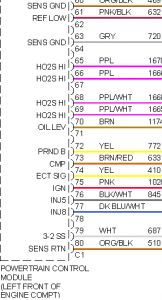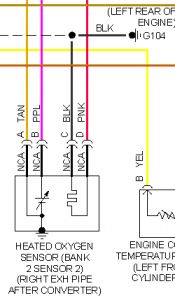VCM supplies a voltage of about .45 volt between HO2S 2 signal and HO2S 2 ground circuits. HO2S 2 varies voltage from about one volt with rich exhaust to 0.1 volt with lean exhaust. HO2S 2 produces no voltage and acts as an open circuit when temperature is less than 600 °F (316 °C). DTC P0157, DTC P0158, an open sensor circuit or a cold sensor causes open loop operation. DTC P0157 determines if HO2S 2 or circuit is shorted low by checking for a lean condition during steady throttle and power enrichment.
For duplication of DTC, ensure no misfire, EVAP system, ECT, IAT, MAF, MAP or TP sensor DTCs are set, no intrusive tests are in progress, no device controls are active, and system voltage is at least 9 volts.
1.Perform On-Board Diagnostic (OBD) system check. See ON-BOARD DIAGNOSTIC (OBD) SYSTEM CHECK under SELF-DIAGNOSTIC SYSTEM. After performing OBD system check, go to next step. 2.Install scan tool. Warm engine to normal operating temperature. Place gear selector in Park or Neutral. Apply parking brake. Increase engine speed to 1200 RPM. Monitor HO2S 2 voltage using scan tool. If voltage is fixed at less than .026 volt (4.3L, 5.0L and 5.7L) or less than .086 volt (7.4L), go to step 4. If voltage is not as specified, go to next step. 3.DTC is intermittent. Check if additional DTCs are set. If any additional DTCs are set, go to applicable DTC test. If no additional DTCs are set, see DIAGNOSTIC AIDS. 4.Turn ignition off. Disconnect HO2S 2 harness connector. Connect a jumper wire between HO2S 2 low circuit of HO2S 2 harness connector (VCM side) and ground. Turn ignition on, with engine off. Monitor HO2S 2 voltage using scan tool. If voltage is .35-.55 volt, go to next step. If voltage is not .35-.55 volt, go to step 6. 5.Check for any condition that may cause HO2S 2 to detect a lean condition. Repair as necessary. After repairs, go to step 10. If no problem is found, go to step 8. 6.Turn ignition off. Remove jumper wire from HO2S 2 low circuit. Disconnect VCM harness connector containing HO2S 2 high signal circuit. Check for continuity between HO2S 2 high signal circuit and ground, and then between HO2S 2 high signal and low circuits. If no continuity is present in either circuit, go to step 9. If continuity is present in either circuit, go to next step. 7.Repair HO2S 2 high signal circuit for short to ground or short to HO2S 2 low circuit. After repairs, go to step 10. 8.Replace HO2S 2. After repairs, go to step 10. 9.Replace VCM. Program replacement VCM using required equipment. Perform Passlock � reprogramming and CKP system variation learn procedures. After repairs, go to next step. 10.Using scan tool, clear DTCs. Start and warm engine to normal operating temperature. Select DTC, SPECIFIC, and then enter this DTC. Operate vehicle within the conditions for setting this DTC. If scan tool indicates that this test ran and passed, go to next step. If scan tool does not indicate that this test ran and passed, go to step 2. 11.Using scan tool, select CAPTURE INFO, REVIEW INFO function If any undiagnosed DTCs are displayed, go to applicable DTC test. If no undiagnosed DTCs are displayed, system is okay.
3/19/20
Diagnostic Aids
Using scan tool, observe Long Term (LT) fuel trim values at different RPM and airflow conditions. Scan tool should display fuel trim cells so that LT fuel trim values can be check in each cell to determine when DTC may have set. If DTC is set, LT fuel trim values will be about 158 or greater.
Check for mispositioned HO2S wire pigtail contacting exhaust manifold. Check for intermittent ground in wire between connector and sensor. Check for poor VCM to engine block ground. Check for lean fuel injectors. Check for water near in-tank fuel pump inlet that may be delivered to injectors. Water causes a lean exhaust and can cause DTC to set.


Wednesday, March 31st, 2021 AT 10:00 AM
(Merged)

